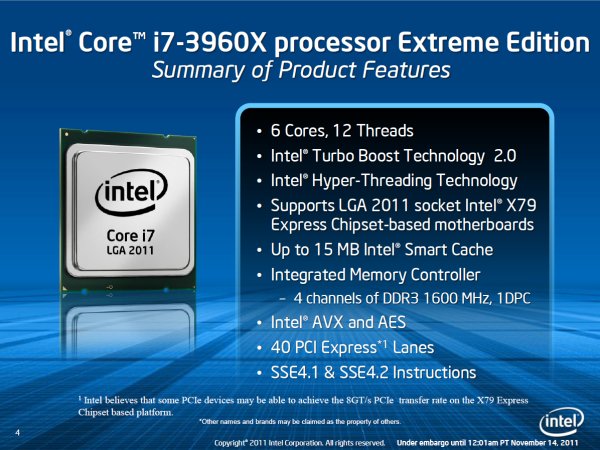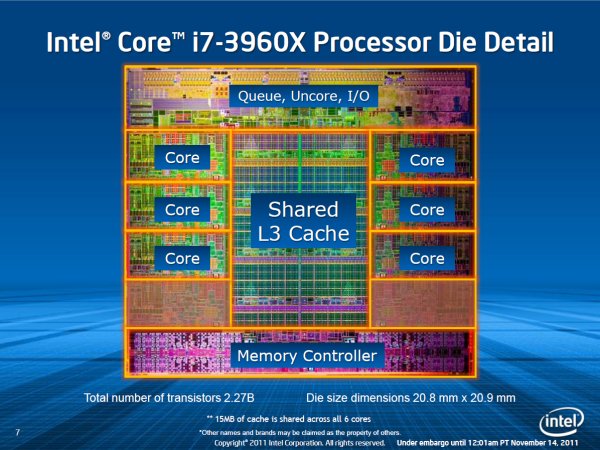Sandy Bridge-E Lineup
The Sandy Bridge-E launch lineup consists of three processors. King of the hill is the Core i7 3960X Extreme Edition, a fully unlocked chip featuring 6 cores with Hyper-Threading for 12 thread support. This model comes clocked at 3.3GHz with a Turbo frequency of up to 3.9GHz and TDP rating of 130 watts.
Like all Sandy Bridge-E processors it supports quad-channel DDR3-1600 memory. However unlike some Extreme Edition models, the new Core i7 3960X receives a massive 15MB L3 cache which is shared across all six cores. The 3960X sticks to the conventional Extreme Edition pricing with a MSRP of $990.
Under the Core i7-3960X we have the more reasonably priced Core i7-3930K at $555. With a base clock of 3.2GHz across six cores it can scale up to 3.8GHz using Turbo Boost. The key difference between the Core i7 3960X and the Core i7-3930K is the L3 cache capacity which has been downgraded to 12MB.

It seems unlikely that the extra 3MB (25% increase) of L3 cache would provide enough performance to justify the ~80% increase in price of the Core i7-3960X. That said, users have always had to pay absurd price premiums to get their hands on Extreme Edition CPUs.
Finally, Intel is also releasing the Core i7-3820 which will be the cheapest of the three, though official pricing is yet to be finalized. Clocked at 3.6GHz with a Turbo Boost speed of up to 3.9GHz, the Core i7-3820 is actually clocked the highest of the three Sandy Bridge-E processors. However it's also a quad-core processor supporting eight threads using Hyper-Threading just as the outgoing Core i7-2600K does.

The Core i7-3820 has the added benefit of a quad-channel memory controller opposed to the dual-channel controller of the Core i7-2600K. It also sports 2MB of additional L3 cache, bringing the grand total to 10MB. Lastly, the Core i7 3820 supports partial overclocking which allows core multiplier adjustments to a preset maximum, though at this stage we are unsure as to what that preset is.
Another important feature of the updated Sandy Bridge-E architecture is PCI Express bandwidth. The new processors provide up to 40 lanes of PCIe 2.0 bandwidth for PCI Express devices, which can include graphics cards, storage controllers and additional LAN devices. This translates into more than 2x the PCIe lanes when compared to the original Sandy Bridge desktop processors.
For multi-GPU configurations using either Crossfire of SLI technology, the Sandy Bridge-E processors can provide full x16 bandwidth to two cards while a third can be fed x8 bandwidth. Alternatively users can configure the processor for one slot at 16x and another three at 8x.
